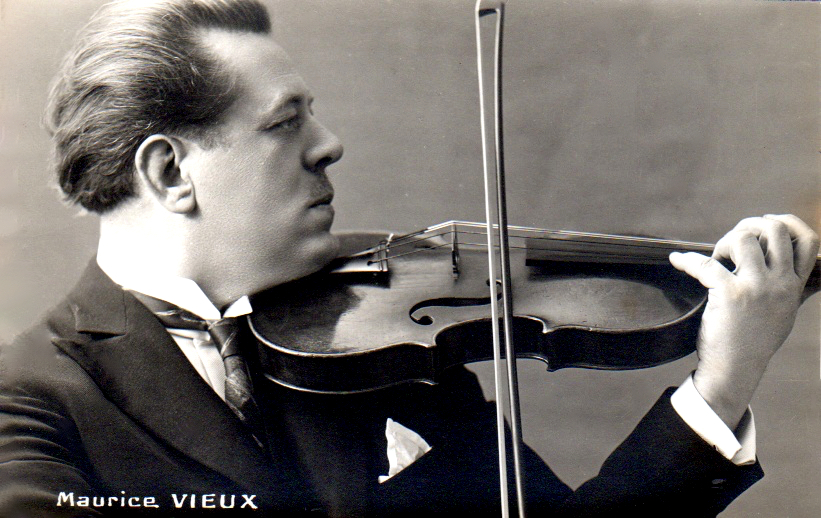This bow was displayed in the Colonial Exposition held in Paris at the Bois de Vincennes in 1931, which drew millions of visitors. These commercial exhibitions had started in France at the end of the 18th century and were designed for the French arts and craft industry to show off its capabilities. J.B. Vuillaume and Eugène Sartory took part in these more than anyone else in the violin making industry.
It seems that the bow was a gift to the violist Maurice Vieux, as shown by the dedication engraved on the ferrule: ‘A Mce Vieux, Estime et reconnaisance’ (see our previous feature about Vieux). Dedicating bows was a great tradition throughout the 19th century, and Sartory dedicated quite a few of his to musicians, always using the same (unknown) engraver in Paris. Queen Elisabeth of Belgium, who knew Sartory through Ysaÿe, is known to have commissioned dedicated Sartory bows as gifts for the musicians she played with. We’ve found letters at the Belgian embassy in Paris requesting bows by a certain Sartory, to which the ambassador responded with some panic: ‘Indeed there is a bow maker named Sartory but he currently is in Saint Tropez and unreachable, so we cannot access to Her Majesty’s request.’

The French violist Maurice Vieux, who owned the Sartory bow until his death in 1951. Photo: courtesy Jean-Claude Vieux
There are two reasons a bow maker becomes successful. Firstly, consistency in quality. Unlike Voirin, who made some extraordinary bows but also some that are too light, Sartory is very consistent – it’s very rare to find a bad Sartory. Although he employed various excellent bow makers, including Louis Morizot pere, Louis Bazin, Louis Gillet, and Jules Fetique, he always demanded his own standard of quality. One can see some variations in the work, but the quality is always very high. Secondly, the volume of production. Picasso produced three paintings a day; Sartory produced three bows a week. This was an enormous production and, like Stradivari, it’s the sheer volume of excellent bows that led Sartory to such high recognition.
Picasso produced three paintings a day; Sartory produced three bows a week. This was an enormous production
Sartory studied with his father in Mirecourt, then with his uncle, André Vigneron, in Paris. Unusually, he established his own shop aged just 18; seemingly he had already reached a maturity of style despite his youth and decided to set up on his own. He was very traditional in his approach to bow making, while still making bows according to the tastes of his time. The modern music of the 20th century demanded more rigid bows, which is what Sartory produced, while keeping a classical approach to making. Around 1930 his bows become stronger and more powerful, as can be seen in this example.
Sartory’s dedicated bows are always of high quality, and this one is no exception. It has a beautiful stick of superior quality wood compared with what was typically used in Paris in the 1930s, when Lamy, Thomassin and Fetique were still active. This is the best wood one can find – the stick is firm, which allows it to respond well to the demands of today’s musicians. It features the full-cap button and Parisian eye so often found on Sartory bows. In fact Sartory created a fashion in bow making: the full-cap button and the Parisian eye already existed (we start seeing Parisian eyes as early as 1875), but they weren’t consistently used. Sartory used the Parisian eye almost exclusively, mostly with a full-cap button, and with them created his brand image, which other makers later copied.
Sartory’s dedicated bows are always of high quality, and this one is no exception
The bow is in excellent condition. One can see it has been played because of the patina, but it’s not worn, probably because Maurice Vieux didn’t have very acidic perspiration.
The button is a replacement probably made in Paris in the 1960s. Let’s place the bow in its historical context: at the time bows weren’t expensive, and between 1931 and 1951, when Vieux died, it’s possible the screw wasn’t oiled properly during use. There had also been a decrease in the care of instrument restoration after World War I, and instead of simply replacing the screw and the eyelet of the button, an entirely new one was put on. Since then restoration philosophy has changed and bow makers would now try to preserve the original button rather than replacing it.
It is rare to find a second-generation Sartory bow like this one on the public market: Vieux was its first owner and it comes directly from his family. After this it will be dispersed among musicians.
Based in Belgium, Pierre Guillaume is one of the world’s most respected bow experts.
The Sartory bow is Lot 30 in our October London sale, which also includes a Caressa & Français viola formerly owned by Vieux. View full sale.